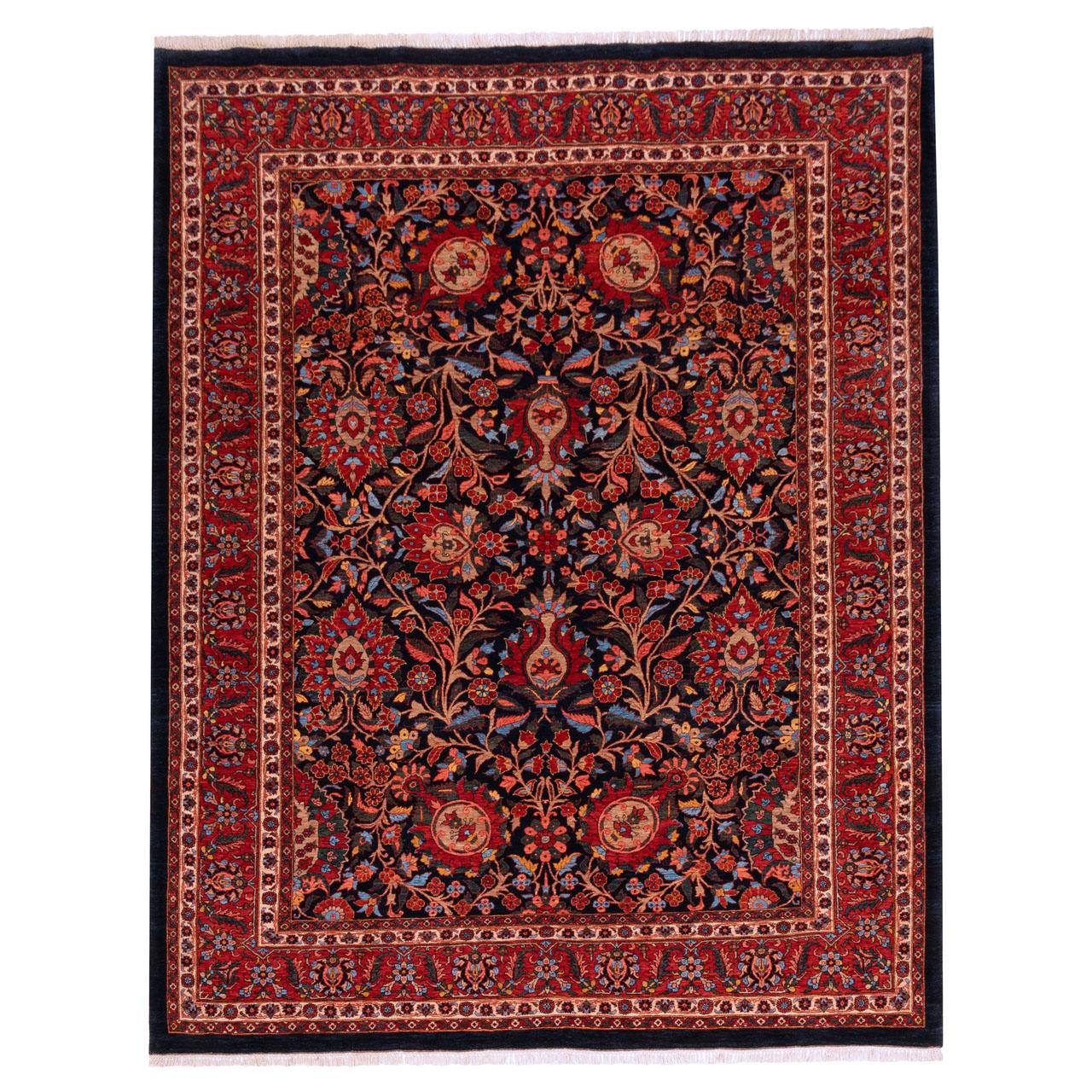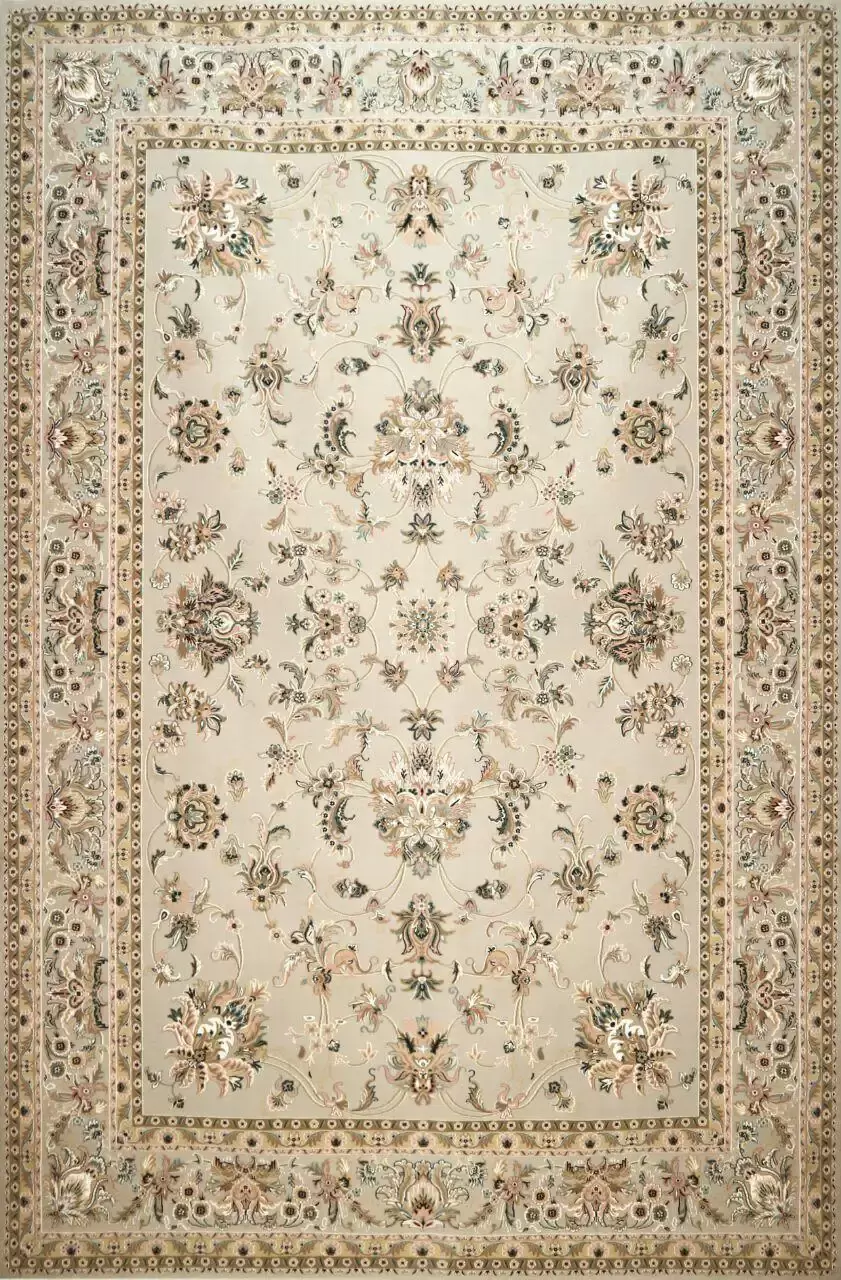Shah Abbasi flower pattern on Iranian carpet
Shah Abbasi flower is one of the common motifs among many Iranian arts, especially hand-woven carpets. This pattern is beautifully printed on many carpets of different regions of Iran in different shapes and colors, and it can be said that it is currently one of the most common designs in Iranian carpets. In this article, we introduce the role of Shah Abbasi and its types in handwoven carpets.
The origin of the role of Shah Abbasi
Plant motifs are sometimes used in an objective and real form, sometimes in an abstract and stylized form in decorations and arts. Sometimes images such as roses, hundred leaves, red flowers, spiral bushes, flower threads, flower motifs and vases, tree of life, bushes with all kinds of beautiful and colorful flowers are depicted objectively while maintaining the aspect of realism. Plant motifs are sometimes displayed in various slime and khatai with wavy and magnificent movements. In this way, the artist tries not only to show plant motifs from the point of view of the level of naturalism that can be seen in the leaves and flowers, but in a deep way from the point of view of the spiritual, spiritual sense and also the impact on the soul and soul of these paintings. use it and give them a permanent movement by combining plant motifs into a flow of wavy lines and turning them into a kind of rotation of ivy and mobile leaves.
Gol Shah Abbasi's background
Although Islamic and Khatai designs have their roots in pre-Islamic art, but with the arrival of Islam in Iran and the restriction created by Sharia to draw human faces and some animals, these designs grew in Islamic art and went through their evolutionary stages. Goljam or Shah Abbasi flower in carpet weaving is a flower that has attracted the thoughts of Chinese and Egyptian people for thousands of years and is a sign of freshness. In the Old Testament, it was accepted in Asia and the symbol of the sun was among these peoples. In the works obtained from Hamedan province, we come across a bronze cup with the early Shah Abbasi flower engraved on it. It can be said that this flower goes back to the Achaemenid period. The best example of Shah Abbasi's flowers can be seen in the plasterwork of the altar of Malek Mosque in Kerman.
The peak of glory and the use of Shah Abbasi motifs
One can see the peak of the use of these motifs in the arts of the Timurid and Safavid periods. Shah Abbas I of Safavid, who received the title of Shah Abbas the Great, was one of the most powerful and influential Safavid kings. Shah Abbas fought with Uzbeks, Ottomans and Portuguese and won. He established many large workshops for weaving carpets and fabrics. The texture of these handlooms, which have very pleasant decorative motifs, in addition to beautifying the royal palaces, have also been donated to some kings of other countries. At this time, the expansion of the capital and new buildings, on the other hand, increased the need for carpets, and carpet weaving became one of the most important economic fields for the people. According to the order of Shah Abbas, workshops were established in Estrabad, Shirvan, Qarabag, Kashan, Gilan and Mashhad. The fact that the products of a city are known by the name of its sales center has a long history; So Chardon also states in his travel letter that the carpets produced in the excellent carpet weaving workshops in Kerman and Sistan were called Turkish carpets in Europe. Because it entered Europe through Türkiye. During the time of Shah Abbas I, carpet production was carried out in Herat, which was considered the capital of Khorasan at that time. In the year 1012 A.H., a Portuguese traveler in his description of Iranian carpets said that the most beautiful, fine and expensive carpets were produced in Yazd, Kerman, and the third class of high-quality carpets in Khorasan. It should be noted that Shah Abbasi's flowers appear mainly in the field of Khatai motifs. It is as if a mistake is like a string to which the mentioned flowers are tied.
How to draw Shah Abbasi flower in the carpet
This flower is known by different names such as Laleh Abbasi, Abbasi and Sheikh Safi. It is the most important and beautiful flower of traditional design and especially the carpet, which can be boldly introduced as the bride and king of traditional design. The great carpet designers have tried their best to express their maximum creativity and innovation in the design of this flower, and for this reason, we have many different examples of it now. The Shah Abbasi flower is placed on the main band of Khatai and is the origin of many decorations on the band of Khatai. Shah Abbasi flower is presented in oval and circle formats. Because this flower is one of the symmetrical flowers, when drawing, half of the flower is usually drawn and the other half is obtained by the reflection method. The drawing method is that they first draw or assume the line of symmetry and then draw the flower according to the steps that will be mentioned:
1- The egg and the nucleus of the flower are drawn.
2- The petals are stretched from the bottom to the top and from small to large in the center of the flower egg and around the flower core.
3- The space between the petals is filled with flower chak.
4- At the end, they compare and complete the flower from the line of symmetry.
Characteristics of Shah Abbasi flowers
The characteristic of Shah Abbasi flower is that a specific stem is drawn at the end of the flower and it is used as five, seven and sometimes twelve flowers, and its main difference in the wrong state is that the flower is more open. This flower is the most perfect flower. It consists of repeating two leaves and two circles, and it is the most flexible pattern of flowers. The role of the Shah Abbasi flower is considered to be derived from the lotus flower and the pomegranate flower, which have been popular in the art of this land since ancient times, and finally, with a lot of interference, it has become the present day Shah Abbasi flower. Some consider jujube as the inspiration for the circular design of Shah Abbasi's flower and claim that the jujube and the twisting of the broken lines of its crown and its resemblance to pomegranate and pomegranate flower, as well as its sacred aspect, caused artists to use it in their roles. Shah Abbasi is one of the flowers that is also known as pomegranate flower, leopard paw. It has different types such as knotted flower, ivy, leafy flower, leafy flower, three-flowered leafy flower, and pomegranate, which is famous for its pomegranate design. The general feature of all types of Shah Abbasi flowers is that:
- All of them are adapted from pomegranate and lotus flowers.
- They all have a round, egg-shaped form.
- All have the same form in the center of the flower.
- They are used to decorate Khatai and Slimi bands.
- Due to the fact that they have many decorations, they have variety.
- This flower can be seen in most traditional arts of Iran.
- Due to its sacred and mythological background, it has been given a lot of attention in Islamic arts.
- In most of the existing carpets, the role of this flower is common and they differ only in color. In different carpet weaving regions, Shah Abbasi flowers have various forms, but in general, 21 species of this flower are common between the regions.
 Types of Iranian handwoven carpets with Shah Abbasi design
Types of Iranian handwoven carpets with Shah Abbasi design
Shah Abbasi Afshan carpet
Shah Abbasi Afshan carpet is actually like a garden full of flowers. This design does not have elastic and fringe, and instead, the entire carpet is filled with the twisting of beautiful Khitai and Slimi motifs. Finally, this garden full of flowers is limited by using wide and narrow borders. Afshan Shah Abbasi carpets are usually designed as a one-half or one-fourth spread; That is, one part of the four parts of the carpet is designed, and by repeating it, the entire text of the carpet is designed.
Shah Abbasi Lachak and Toranj carpet
Tangerine is called the circle, oval or rhombus pattern in the middle of the carpet, and the lath is obtained by repeating a quarter of the tangerine in the corners of the carpet. In the design of Shah Abbasi lace and tranj, the space of tranj, laces, border and sometimes the text of the carpet is also filled with beautiful Slimi and Khatai motifs along with Shah Abbasi flowers.
A checkered Shah Abbasi carpet
Shah-Abbasi Taredar carpet is somewhat similar to Lakh and Taranj designs, with the difference that there is no Lakh in the corners of the Shah-Abbasi Tareh-dar carpet. In other words, in this design of the Shah Abbasi carpet, the lach covers the carpet all the way around. In fact, the design of this carpet is such that first the border of the carpet surrounds it, then the threads are stretched all around the carpet after the border; And finally, there is a delicate bergamot in the middle of the carpet. All the mentioned parts are decorated with twists of Khatai stems and Shah Abbasi flowers.
Shah Abbasi Sheikh Safi carpet
The basis of this design is taken from the famous carpet of the tomb of Sheikh Safiuddin Ardabili belonging to the Safavid period. In the Shah Abbasi carpet of Sheikh Safi, a type of Shah Abbasi flower is used, which is called melon flower. This type of Shah Abbasi flower is used both to decorate the bergamot and to decorate the lace in these carpets.
Shah Abbasi animal carpet
This type of Shah Abbasi carpet, the texture of which is more common in Qom and Kerman, is that in the center, all kinds of Shah Abbasi and Khatai flowers are woven, and around these flowers, there are edges and laces that use the pattern of different animals such as deer. , wolf, lion and gazelle are decorated. The search and struggle of these animals around Shah Abbasi flowers gives a very beautiful and spectacular effect to these carpets.
Final word
Shah Abbasi flower is one of the most beautiful and common designs in Iranian carpets, and many regions of Iran, including Tabriz, Qom, Kashan, Isfahan, Khorasan, Nain, etc., produce beautiful examples of this carpet in a wide variety of colors. In fact, carpets with Khataei designs and Shah Abbasi flowers are reminiscent of authentic Iranian art and culture all over the world.
You can inquire about Buying Handwoven Carpets , Buying Handwoven Kilim and Mats , and Buying Handwoven Pictorial Rug Tableaus online from the Hoveida Carpet Store and register all your orders and Wherever you are in the world, deliver it to the desired address in less than 4 working days.
If you are interested in reading other articles in the field of Handwoven carpets or Handwoven Pictorial Rug Tableaus , please refer to Hoveida Carpet Commercial .
Leave a comment
Your email address will not be published. Required fields are marked *












